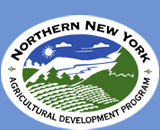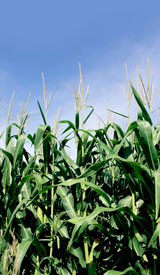April 15, 2009
NNY Research Project Developing Strategies to Manage Brown Root
Rot
Northern New York has the dubious distinction of being the first region
to identify the presence of brown root rot in the state, but it can also
claim a proactive approach to dealing with the cold weather-active,
soil-borne disease caused by the fungus Phoma sclerotioides
that affects alfalfa crops.
A 2009 Northern New York Agricultural Development Program project has
Cornell University plant pathologist Gary C. Bergstrom, graduate student
Michael Wunsch, and plant breeders Julie Hansen and Donald R. Viands
assessing the range of brown root rot (BRR) in NNY and beginning to
develop BRR management strategies.
The research team members say they have the opportunity to address one
of the factors contributing to reduced productivity and longevity of
alfalfa crops by identifying alfalfa varieties that better withstand the
fungus in BRR-infested soils in NNY.
“Brown root rot is most severe in regions with harsh winters such as
Northern New York. Because there are at least four genetically distinct
biotypes of the brown root rot fungus present in New York and the
relative resistance of alfalfa varieties to brown root rot appears to
differ by biotype, the testing of alfalfa varieties for resistance in
the naturally-infected soils of Northern New York has great value in the
identification of varieties that will have the potential to grow well in
the region,” says Bergstrom.
To help the efforts to develop BRR management strategies, farmers can
scout their fields now for the crop damage caused by the fungus.
“April through early May is the best time to assess over-wintered
alfalfa for signs of brown root rot on roots and crowns. If alfalfa that
looked great last October is slow to emerge this spring or appears to
have ‘winterkilled,’ brown root rot may be a contributing cause,”
Bergstrom says.
Absolute confirmation of brown root rot (BRR) requires a laboratory test
that is now available from the Cornell University Plant Diagnostic
Clinic. Farmers should call 607-255-7850 prior to submitting samples.
The test costs $40 per composite field sample.
Michael H. Davis, an agronomist with the Cornell University Agricultural
Experiment Station at Willsboro, notes, “This pathogen could
significantly impact dairy farmers in Northern New York. The brown root
rot experiments being conducted on the E.V. Baker Research Farm in
Willsboro and the agronomy plots at the W.H. Miner Agricultural
Institute in Chazy, are an important step toward the development of an
effective management strategy.”
Researchers have found that forage grasses such as bromegrass, tall
fescue, orchardgrass, reed canary grass, perennial rye, and timothy are
all moderately susceptible to P. sclerotioides. The forage
grasses do not suffer as much damage as alfalfa crops, but act as a host
reservoir for the pathogen.
“We have not yet diagnosed an alfalfa field as lost to brown root rot in
Lewis County, but the Cornell survey has alerted us that the pathogen is
present in the county. Although it does not appear brown root rot will
have a significant impact on forage grasses, knowing that the grasses
can harbor the pathogen and continuing research to develop management
strategies and BRR-resistant varieties of alfalfa will be important in
reducing the chances for problems for our alfalfa growers,” says Field
Crops Educator Joseph R. Lawrence with Cornell Cooperative Extension of
Lewis County.
Dairy farmer Dan Chambers of Heuvelton in St. Lawrence County grows 450
acres of alfalfa and forages. He says, “Farmers have to be vigilant
about scouting crops for problems. The region-specific research made
possible by the Northern New York Agricultural Development Program, the
New York Farm Viability Institute, state funding and Cornell provide us
with valuable information and resources to prevent or reduce crop damage
and economic losses.”
Bergstrom and Wunsch say, “There is no action that alfalfa producers can
take currently to control BRR, but with the support from the Northern
New York Agricultural Development Program we expect that ongoing
research will change that.”
Brown root rot was first confirmed in New York State in Clinton County
in 2003 in Cornell test plots at the W.H. Miner Agricultural Research
Institute in Chazy. Brown root rot is now known to occur throughout New
York State, Vermont, New Hampshire and Maine.
Photos showing the damage the disease causes on alfalfa on the Northern
New York Agricultural Development Program website with the results of
other regional on-farm research at www.nnyagdev.org. # # #
Contacts:
• Gary C. Bergstrom, Cornell University, 607-255-7849
• Michael H. Davis, Cornell University Agricultural Experiment Station
at Willsboro Farm Manager, 518- 963-7492
And Cornell Cooperative Extension:
• Clinton/Essex counties: Anita Deming, 518-962-4810
• Franklin/St. Lawrence counties: Stephen Canner, 315-379-9192
• Jefferson County: Mike Hunter, 315-788-8450
• Lewis County: Joe Lawrence, 315-376-5270



